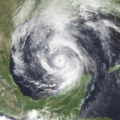Hurricane Opal
Hurricane Opal was a major hurricane that formed in the Gulf of Mexico in September 1995.
| Category 4 major hurricane (SSHWS/NWS) | |
 Hurricane Opal in the Gulf of Mexico | |
| Formed | September 27, 1995 |
|---|---|
| Dissipated | October 6, 1995 |
| Highest winds | 1-minute sustained: 150 mph (240 km/h) |
| Lowest pressure | 916 mbar (hPa); 27.05 inHg |
| Fatalities | 59 direct, 10 indirect |
| Damage | $3.9 billion (1995 USD) |
| Areas affected | Guatemala, Yucatán Peninsula, Alabama, Florida Panhandle, Georgia, most of eastern North America |
| Part of the 1995 Atlantic hurricane season | |
Opal was the 9th hurricane of the highly active 1995 Atlantic hurricane season. Opal was the strongest hurricane of the 1995 Atlantic hurricane season. It crossed the Yucatán Peninsula while still a tropical depression from September 27, then strengthened northward in the Gulf, becoming the most powerful Category 4 Atlantic hurricane before making a second landfall, October 4, in the Florida Panhandle near Pensacola as a 125-mph (201-km/h) hurricane. Opal devastated the Pensacola/Panhandle area with a 15-ft (5-m) storm surge and travelled up the entire state of Alabama, becoming a tropical storm in Tennessee. Opal also caused heavy damage in the mid-Atlantic states before dissipating.
Afterward, 50 people had died from flooding by Opal in Guatemala and Mexico, with another 13 deaths in the United States directly or indirectly related to Opal. Preliminary damage estimates were $3 billion.[1]
Meteorological history
The beginning of this storm started from a tropical wave that moved off of Africa on September 11. It disappeared into a low pressure while in the Caribbean Sea several days later. The wave was found again on September 27 and was good enough to become Tropical Depression Eighteen. Tropical Depression Eighteen made landfall in the Yucatán Peninsula shortly afterword. On September 30 Tropical Depression Eighteen strengthened into Tropical Storm Opal. Tropical Storm Opal continued west until October 2. On October 2 it turned northeast and strengthened into Hurricane Opal. After that Hurricane Opal strengthened fast and reached it's top winds of 150 mph (making it a category 4) on October 4, only two days after becoming a hurricane. Hurricane Opal continued northeast and weakened a little and made its last landfall in Santa Rosa Island, Florida on October 4 while a category 3 hurricane. Hurricane Opal became a tropical storm over central Alabama and did not weaken to a tropical depression till it was in Tennessee. Tropical Depression Opal became extratropical over the Ohio River Valley on October 5th.[2][3]
Retirement
- REDIRECT Template:See also
The name "Opal" was retired in the spring of 1996. In 2001, the name "Olga" was used instead, Olga was also used in 2007, and could be used in 2013.
Hurricane Opal Media
Hurricane Opal rapidly intensifying in the Gulf of Mexico on October 3
Hurricane Opal near landfall in Pensacola, Florida as a Category 3 hurricane
Related pages
References
- ↑ "weather.com — Storm Encyclopedia" (section "Hurricane Opal"), Weather.com, 2007, webpage: WeatherCom-1995-storms Archived 2007-06-24 at the Wayback Machine.
- ↑ "Hurricane Opal - October 4, 1995". National Weather Service. October 4, 1995. Retrieved October 7, 2017.
- ↑ "Preliminary Report Hurricane Opal 27 September - 5 October 1995". National Hurricane Center. Archived from the original on September 6, 2008. Retrieved October 7, 2017.





